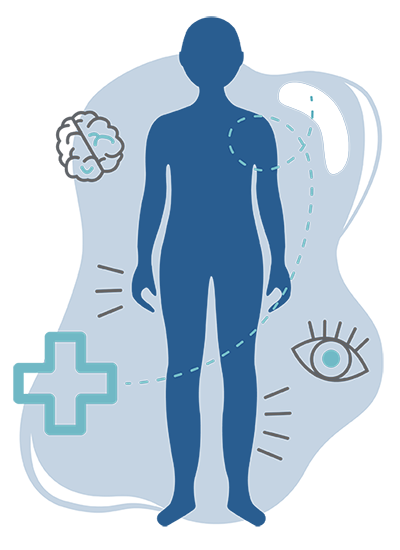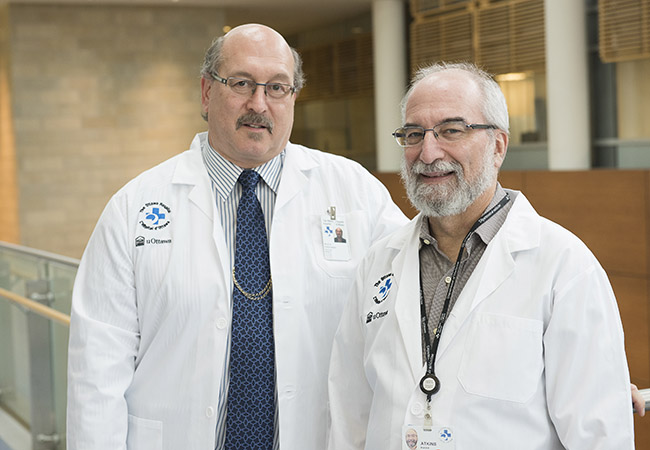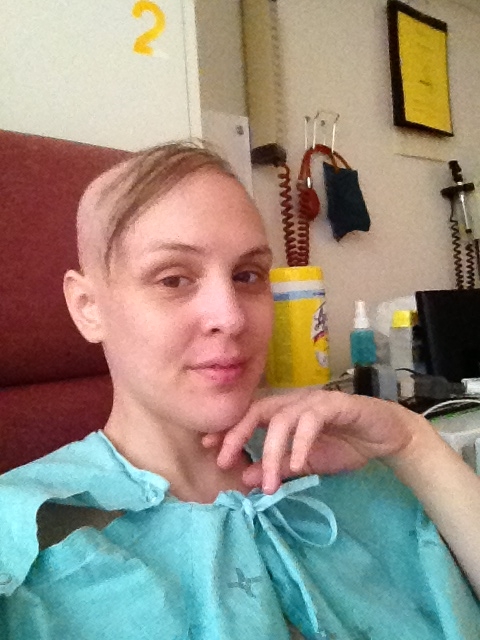Update: As of October 2025, Geneviève is doing incredibly well. Her MS remains stable with no signs of progression, and she continues to embrace life to the fullest.
Published: September 2022
When Geneviève Bétournay reflects on the past decade, she thinks about the adversity she has overcome. As the owner of the Art House, a coffee house/art gallery, she’s endured keeping her business alive during the pandemic. However, an even bigger challenge was her diagnosis of multiple sclerosis (MS) in 2010. Today, thanks to a life-changing stem cell transplant at The Ottawa Hospital, she has a whole new perspective on the possibilities that lie ahead for her.
Geneviève is no stranger to adapting to change. She was in her early 20s and going to university when she started to have issues with her vision. Especially during stressful times, her vision would become blurry, but she didn’t associate it with anything more serious. That changed when she was 23 and living in Japan — new symptoms emerged. “I had more issues with my vision. It was getting worse and that was scary. Also, my foot would drop — it would drag when I tried to move it and there were other issues related to movement,” recalls Geneviève.

News of MS diagnosis hits hard
When she returned home from Japan, she started to seek answers, but it was some time before anyone would connect the dots and uncover the problem. “Ultimately, it was the vision issues that ended up getting me to see a neurologist because basically, my optometrist was able to get my prescription right, but my vision was still blurred,” explains Geneviève.An MRI finally provided Geneviève with answers. But along with those answers came the shock of an MS diagnosis.
“What is life with MS? What would life even look like? It just sounded scary. I didn’t know what was going to happen to me.”
– Geneviève Bétournay
MS is a condition that can affect the brain and spinal cord, causing a wide range of potential symptoms, including problems with vision, arm or leg movement, sensation, and balance. For Geneviève, there were so many unknowns and even more questions. “What is life with MS? What would life even look like? It just sounded scary. I didn’t know what was going to happen to me,” she says.

Fatigue, cognitive disruption, mood changes
Vision issues such as vision loss, blurred vision, and double vision
Difficulty with speech and swallowing
Incontinence and digestive problems
Difficulty with hand-eye coordination and numbness/tingling in hands
Sexual dysfunction
Loss of power in a limb or numbness
Walking difficulties and balance problems
Effects of MS on the body
- Fatigue, cognitive disruption, mood changes
- Vision issues such as vision loss, blurred vision, and double vision
- Difficulty with speech and swallowing
- Incontinence and digestive problems
- Difficulty with hand-eye coordination and numbness/tingling in hands
- Sexual dysfunction
- Loss of power in a limb or numbness
- Walking difficulties and balance problems
Groundbreaking MS treatment pioneered in Ottawa
Once Geneviève and her family processed the news of her diagnosis, she learned everything she could about the illness. A family friend, who happens to be a nurse, had heard a lot about Dr. Mark Freedman and his transformational MS stem cell transplant research in collaboration with Dr. Harold Atkins and encouraged Geneviève to get in touch with The Ottawa Hospital’s MS Clinic. Meeting Dr. Freedman was a pivotal day that would shed new light on her future. “I see it as one of those very lucky life-changing moments when I made that call,” explains Geneviève.
Twenty-four years ago, many were skeptical when Drs. Atkins and Freedman first proposed the idea of using stem cells to reprogram the immune system to halt the progression of MS. Today, they are known for pioneering this groundbreaking treatment which is now being used in many countries around the world. In fact, it was serendipity that led Dr. Atkins, a hematologist, and Dr. Freedman, a neurologist, to meet while they were working on a different project. The two started to discuss stem cell transplants and that would ultimately lead to the transformation of MS treatment.
While this was a time of uncertainty for Geneviève, she felt she was in the right hands to handle the complexity of her case. “Dr. Freedman was very kind from the beginning. It was very comforting to know that there were multiple treatment options if something didn’t work.”

Initially, Geneviève received the first line of treatment for a year that included injections every two days; however, it didn’t provide positive results. Next in line was a form of chemotherapy that targeted her immune cells. She remained on that treatment for two years, but once again, the results didn’t have the impact her medical team had hoped for, so, in January 2013, Dr. Freedman recommended the MS stem cell transplant.
MS symptoms were progressing quickly
At this point, Geneviève’s MS was progressing quickly. Both of her eyes were now affected, and increasingly her mobility was impacted. “I felt numbness below the waist. It was very difficult for me to walk unassisted. I would need something to hold on to — either a person or a wall or something like that. There were also issues with muscle spasms and dizziness,” explains Geneviève.

Headaches were also a challenge, and life was becoming more difficult for this young woman who was working on her Master’s degree at UOttawa. Her degree was in organic chemistry, and lab work was challenging because of blind spots in her vision and a lack of dexterity. When it came time to decide whether to participate in the transplant, she explains there was no decision to make. “I knew about this treatment from the beginning. It was always in the back of my mind. I had already processed it. I do remember being sad that nothing else had worked and I had to do this or else my condition would continue to go downhill rapidly. It gave me hope but it was a very emotional day,” recalls Geneviève.
“I felt numbness below the waist. It was very difficult for me to walk unassisted. I would need something to hold on to.”
– Geneviève Bétournay
She remembers the compassionate support she received from Dr. Freedman when it was time to consider the transplant. He explained it would be one of the hardest decisions she’d ever make and encouraged her to take the time to make sure it was right for her.
Geneviève learned that she could become infertile because of the procedure, so in the few months before her transplant, she had some of her eggs harvested and she also received a shot that could allow her eggs to go into “hiding” during the treatment.
Time for the MS stem cell transplant
In July 2013, Geneviève received her stem cell transplant. The process begins with purifying and freezing the patient’s stem cells which will later be “cleaned” in the lab. The next step is a strong chemotherapy treatment to destroy the patient’s immune system. The final step is the transplant of the clean stem cells back into the patient — that’s when a new immune system starts to develop.
It’s not an easy process, but Geneviève was focused on what the result might give her. “Mentally and physically, it was challenging, but to be honest, I’m a different person today because I went through that.”
How did a stem cell transplant halt MS?
“Those moments where something happened that I wasn’t able to do before – it’s like pure euphoria. It was joy. It was gratitude for something that you never thought you’d ever feel again.”
– Geneviève Bétournay
Geneviève says she was in the hospital for eight days before she was able to go home because she didn’t have any major infections or require constant monitoring. Also at that point, her cell counts started to go back up — her new immune system was starting to grow. She returned to the hospital as an out-patient for several months.
The next step was to determine the impact the transplant would have on her overall health. It took between eight and 12 months for Geneviève to recover, and then she started to notice tiny improvements. “That’s when I first noticed I could do something that I couldn’t do before, or I had lost the ability to do. The first thing I noticed was I could lift my right leg, because my right side was more affected than the left.”
As Geneviève saw these small improvements begin, she tried to temper her expectations. She didn’t want to let her hopes get too high, but she admits sometimes she couldn’t resist. “Those moments where something happened that I wasn’t able to do before — it was like pure euphoria. It was a joy. It was gratitude for something that I never thought I’d ever feel again.”
Was it all worth it?
Over the past decade, Geneviève has seen every single symptom get better. From lifting a single toe to moving a foot to being able to jump again, and then walking several kilometres without tripping and falling to the ground — these are big milestones on her road to recovery. The signs of MS are disappearing. “To date, it would seem I have not had any new relapses. No new disease activity. My vision improved, and I continue to recover, albeit very slowly as it takes a while to heal.”
When Geneviève reflects on how far she’s come, had she not undergone the stem cell transplant, she believes she would likely be in a wheelchair today. “It was 100% worth it. Just the fact that I can move blows my mind. I have a great deal of gratitude for the doctors and everything the hospital had done for me.”
And today, with only a slight limp, she walks up the steps into the Art House and appreciates each moment she has to celebrate the creative artists in our city and transformational treatment she received at our hospital. “It’s priceless what I have gained. Aside from developing MS, nothing has had a more extensive impact on my life than undergoing this stem cell treatment. Simply put, it saved my life, or perhaps you could say it gave me a second one.”

“It’s priceless what I have gained. Aside from developing MS, nothing has had a more extensive impact on my life than undergoing this stem cell treatment.”
– Geneviève Bétournay





